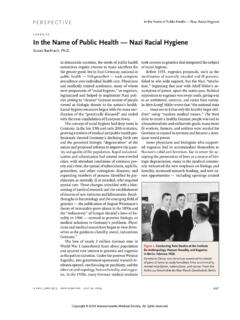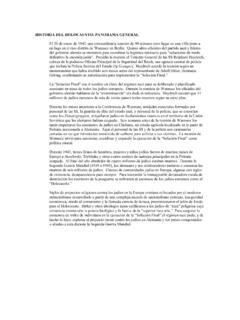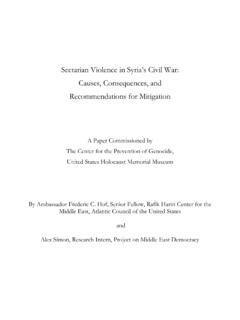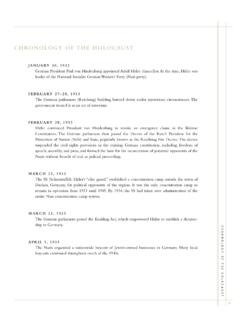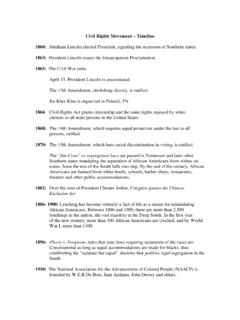Transcription of WHAT IS GENOCIDE? - United States Holocaust Memorial …
1 AN EVOLVING INTERNATIONAL FRAMEWORKThe term genocide was created during the Holocaust and declared an international crime in the 1948 United Nations Convention on the Prevention and Punishment of the Crime of genocide . The Convention defines genocide as any of the following acts committed with the intent to destroy, in whole or in part, a national, ethnical, racial , or religious group, as such:a. Killing members of the group;b. Causing serious bodily or mental harm to members of the group;c. Deliberately inflicting on the group conditions of life calculated to bring about its physical destruction in whole or in part; d. Imposing measures intended to prevent births within the group;e. Forcibly transferring children of the group to another group. The intent to destroy particular groups is unique to the definition of genocide . A closely related category of international law crimes against humanity is defined as widespread or systematic attacks against civilians.
2 This timeline traces the development of the term genocide and its codification into international IS GENOCIDE? Photo: A UN soldier on patrol at Rugari School in eastern Democratic Republic of the Congo, inside the UN buffer zone between the rebel and government forces. June 2008. USHMM/Michael CRIME IS NAMEDB efore 1944, no term existed to describe a coordinated assault on civilian populations. That year, Raphael Lemkin introduced the term genocide to give the crime a name. Lemkin was a Polish-Jewish legal scholar who had fled nazi -occupied Poland and arrived in the United States in : Raphael Lemkin prepares for a talk on UN radio, probably between 1947 and 1951. UN Photo1945 46A NEW, BUT LIMITED, LEGAL SANCTION IS ISSUEDA llied forces codified the general principle of crimes against humanity into enforceable law and prosecuted nazi war criminals for atrocities they committed against both their own and other nation s citizens.
3 However, the law was limited in scope, applying only to crimes committed during an international Charter of the International Military Tribunal (1945) defined crimes against humanity as murder, extermination, enslavement, deportation, and other inhumane acts committed against any civilian population, before or during the war; or persecutions on political, racial , or religious grounds in execution of or in connection with any crime within the jurisdiction of the Tribunal, whether or not in violation of the domestic law of the country where perpetrated. The definition of crimes against humanity was further refined during the process of drafting the Rome Statute (1998), which created the International Criminal : Defendants in the dock at the International Military Tribunal trial of war criminals, Nuremberg, Germany, November 1945. National Archives and Records INTERNATIONAL PROMISE TO PREVENT AND PUNISH genocide IS MADEDue in no small part to the efforts of Raphael Lemkin, the UN Convention on the Prevention and Punishment of the Crime of genocide was unanimously adopted on December 9, 1948.
4 The Convention entered into force on January 12, 1951, after more than 20 countries from around the world ratified : On October 14, 1950, the number of countries that signed the genocide Convention surpassed the 20 necessary for the Convention to come into effect, which it did in January 1951. Pictured are several delegates from signatory nations: (front, from left) Korea, Haiti, Iran, France, and Costa Rica; (rear, from left) Assistant Secretary General for Legal Affairs, Secretary General, a representative from Costa Rica, and Raphael Lemkin, the Convention s chief proponent. UN Photo1950 1990sTHE PROMISE GOES UNFULFILLEDM assive atrocities against civilian populations were committed in the years following the Holocaust and throughout the Cold War. The very countries that signed their names to the genocide Convention, however, scarcely considered whether these atrocities constituted : Not one country invoked the genocide Convention when the Khmer Rouge regime (1975 79) in Cambodia caused the deaths of an estimated million people.
5 Cambodia itself ratified the Convention in 1950. These prisoners were interred at Tuol Sleng (Security Prison 21), a secret center operated by the Khmer Rouge in Phnom Penh, Cambodia. Documentation Center of Cambodia, Phnom United States RATIFIES THE CONVENTIOND espite facing strong opposition by those who believed it would diminish sovereignty, President Ronald Reagan signed the 1948 UN Convention on the Prevention and Punishment of the Crime of genocide on November 4, 1988. Among the Convention s most vocal advocates was Wisconsin Senator William Proxmire, who delivered more than 3,000 speeches before Congress arguing for its : William Proxmire (1915 2005) served in the Senate for the state of Wisconsin from 1957 to 1989. Wisconsin Historical Society1993 THE WORLD ACTS TO PUNISH BUT NOT TO HALT ATROCITIES IN THE FORMER YUGOSLAVIAT argeted civilian groups suffered brutal atrocities throughout the conflicts in the former Yugoslav republics of Croatia (1991 95) and Bosnia-Herzegovina (1992 95).
6 Though the international community showed little will to stop the crimes as they were taking place, the UN Security Council did establish the International Criminal Tribunal for the former Yugoslavia (ICTY) in The Hague. It was the first international criminal tribunal since Nuremberg and the first mandated to prosecute the crime of genocide . Nonetheless, the single worst atrocity to occur in Europe since the Holocaust came two years later. In July 1995, the Bosnian Serb army overran the UN-declared safe haven of Srebrenica. In the following days, the army killed some 8,000 Bosniak men and boys. This incident would later be judged to have constituted genocide by the ICTY. In total, 100,000 people died during the Bosnian conflict; some 80% of the civilians killed were : When the Bosnian Serb army attacked Srebrenica in 1995, Hasan Nuhanovic and his family sought shelter at the UN base with some 30,000 other civilians.
7 When the Dutch UN peacekeepers handed the civilians over to the Bosnian Serbs, who separated men from women and children, Nuhanovic was allowed to stay on the base because he had a UN job. His parents and brother were forced off the UN base, and all three were among the 8,000 Bosniaks killed by the Serbs. Hasan Nuhanovic is pictured here in a Bosnian cemetery filled with graves from the 1992 95 war. USHMM/Tarik THE genocide ENDS, THE WORLD CREATES A TRIBUNAL FOR RWANDAFrom April through mid-July 1994, at least 500,000 civilians, mostly of the Tutsi minority, were murdered with devastating brutality and speed while the international community looked on. In October, the UN Security Council extended the mandate of the International Criminal Tribunal for the former Yugoslavia to include a separate but linked tribunal for Rwanda the International Criminal Tribunal for Rwanda located in Arusha, : A cemetery in Nyanza-Rebero, Rwanda, where genocide victims are buried.
8 USHMM/Jerry Fowler1998 THE FIRST CONVICTION FOR genocide IS WONOn September 2, 1998, the International Criminal Tribunal for Rwanda issued the first conviction for genocide after a trial, declaring Jean-Paul Akayesu guilty for acts he engaged in and oversaw as mayor of the Rwandan town of : The skulls of hundreds of victims rest at Ntarama Memorial , one of dozens of churches where Tutsis gathered to seek protection during the 1994 genocide in Rwanda. November 2007. international treaty ratified on July 17, 1998, permanently established the International Criminal Court to prosecute genocide , crimes against humanity, and war crimes. The treaty reconfirmed the definition of genocide found in the 1948 UN Convention on the Prevention and Punishment of the Crime of genocide . It also expanded the definition of crimes against humanity and prohibited these crimes during times of war or treaty defines crimes against humanity as any of the following acts when committed as part of a widespread or systematic attack directed against any civilian population, with knowledge of the attack:Photo: The burning of the Um Zeifa village in Darfur, Sudan, after the Janjaweed looted and attacked it.
9 Brian Steidlea. Murder; b. Extermination;c. Enslavement;d. Deportation or forcible transfer of population;e. Imprisonment or other severe deprivation of physical liberty in violation of fundamental rules of international law;f. Torture;g. Rape, sexual slavery, enforced prostitution, forced pregnancy, enforced sterilization, or any other form of sexual violence of comparable gravity;h. Persecution against any identifiable group or collectivity on political, racial , national, ethnic, cultural, religious, gender as defined in paragraph 3, or other grounds that are universally recognized as impermissible under international law, in connection with any act referred to in this paragraph or any crime within the jurisdiction of the Court;i. Enforced disappearance of persons;j. The crime of apartheid;k. Other inhumane acts of a similar character intentionally causing great suffering, or serious injury to body or to mental or physical United States DECLARES THAT genocide IS OCCURRING IN DARFUR, SUDANT estifying before the Senate Foreign Relations Committee on September 9, 2004, Secretary of State Colin Powell declared that genocide has been committed in Darfur.
10 Though the United Nations and other governments agreed on the scale of atrocities being committed against civilians, they did not declare these atrocities : A man who fled violence in Darfur, Sudan. Touloum refugee camp, Chad, May 2004. USHMM/Jerry Fowler1998A PERMANENT COURT TO PROSECUTE ATROCITIES AGAINST CIVILIANS IS ESTABLISHED
